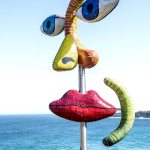Quiet Billionaire’s Next Move
Meghan Lehmann | Oct 13, 2017 | The Australian
Reclusive rich-lister John Gandel made a fortune foreseeing the growth of experiential shopping. Now he’s catching a new wave.
n 2008 John Gandel, the reclusive Melbourne billionaire who made his fortune in retail and property development and counts among his assets the southern hemisphere’s largest shopping centre, bought a magic portal. A 5m-high fibreglass archway, tall as a giraffe and just as funny-looking. Freckled with a mosaic of brightly coloured ceramic tiles, Portal to Another Time and Place by celebrated Australian sculptor Deborah Halpern takes the shape of a face, arcing over to lean on its nose. Two sets of lips pout, inscrutably, below the cyclops stare of one unblinking eye. What to do with such a fantastical thing? Lock it away in a vault? Steal miserly glimpses while cavorting nearby in your Scrooge McDuck pool of gold coins? Not if you’re Gandel.
The 83-year-old is, according to the latest Forbes estimate, worth $5 billion. Though he keeps a low profile, he is consistently ranked among the top 10 wealthiest Australians and is one of the nation’s richest property developers, alongside household names such as Frank Lowy and Harry Triguboff. The businesses he has helped to build include women’s fashion chain Sussan and Melbourne’s colossal Chadstone Shopping Centre. But Gandel inherited the charitable instincts of his hardworking Polish immigrant parents and has always had more on his mind than the accumulation of wealth. Since 1978, he and his wife Pauline have headed one of Australia’s largest family philanthropic funds, Gandel Philanthropy.
Discreet, humble and intensely private, the rich-list couple bequeath as they live: out of the public eye. Over the years, they have distributed tens of millions of dollars to organisations supporting youth education, medical and biotechnology innovation, and various Jewish causes. They are also evangelical in their view of art as a source of societal uplift, a defence against mediocrity, and they donate to a range of cultural institutions, including $7.5 million to the National Gallery of Australia and $1 million to Museums Victoria to develop a fanciful “dinosaur dig” for children.
So what to do with a magic portal if you’re John Gandel? If McDuck-diving into pools of moolah is not your style? Share it with the people, of course. Place it in a magical landscape, along with 50 similarly epic three-dimensional artworks, from voluptuously moulded figures to large-scale feats of engineering. Then invite all the non-billionaires, anyone with some small change and a big imagination, to come to your formerly private domain, 135ha of rugged coastal terrain on the southeastern tip of Victoria’s Mornington Peninsula. Invite them to step through the portal’s cyclops-eyed archway to another time and place, into your $50 million late-life passion project, the most extraordinary new sculpture park in the country: Point Leo Estate.
The sense that you’re following the dream-logic of interdimensional travel begins soon after leaving the urban grey of Melbourne’s outer suburbs. Head south on the EastLink towards the Mornington Peninsula and reality falls away. A giant black bird, 13m high, looms to your left, frozen mid-peck over a yellow cuboid worm. (Or is it a chip? Must ask sculptor Emily Floyd, the most playful of the artists commissioned for this public art program.) Callum Morton’s Hotel, an almost life-size architectural folly that prompts Psycho chills, is the next roadside surprise, followed by Michael Riddle’s Iconoclast, a twisted steel pylon that looks to have been crushed by a large red meteorite. An impossibly tall, polished-steel garden gnome whizzes by and the first-time visitor is left blinking in disbelief. Did that just happen?
These otherworldly beacons set amid the landscape herald entry to a region that has emerged as Australia’s capital of outdoor art. Monumental sculpture, defined as anything over seven metres, is all the rage among the world’s affluent art collectors. At the same time, Henry Moore’s sense that “there is no background better than the sky” has gained popularity and multi-millionaires from Japan to Brazil, New York to New Zealand have turned their backs on the white-walled sterility of museums, preferring to let their collections breathe in the grand galleries of Mother Nature.
In Australia, so-called cultural tourism — the enjoyment of art, fine food and wine in a beautiful natural landscape — is reshaping the Mornington Peninsula. Gandel made a fortune foreseeing the growth in popularity of experiential shopping and he hopes to create a lasting legacy by catching this latest wave. Point Leo Estate evolved organically, he says, from an initial holding of 20ha on the “wild and woolly” side of the Peninsula playground, bought 30 years ago as a bucolic escape for the Gandels and their descendants which, today, include four children, 12 grandchildren and one great-grandchild. The Gandels bought up adjacent parcels of land over the years, expanded a lake at the entrance to the property and, in 2006, planted 20ha of cool-climate vines.
There was no light-bulb moment — the Gandels were simply corralling beauty — but at some point they realised they had an important collection of sculptures, from leading international figures such as Tony Cragg and George Rickey to Australian pioneers of modernism Lenton Parr and Inge King. Some were housed at their Toorak mansion; others, such as Riff, Clement Meadmore’s jazz-inspired twist of painted aluminium, were already at Point Leo. They decided the art should be shared and the seed of a sculpture park was sown.
“We’ve been very fortunate in our lives,” Gandel says now as he picks his way across the construction site that has since risen to become the estate’s centrepiece, a dramatic curvilinear structure designed by Melbourne architect Stephen Jolson. When Point Leo opens later this month, the building will house a cellar door and a restaurant with two dining areas overseen by ex-Rockpool chef Phil Wood. “We’ve worked very hard and we’ve been able to achieve quite a lot and you get to a stage where you feel that you like to do things for other people,” he continues. “You like other people to enjoy what you enjoy.”
The Gandels are so media-shy, they are almost mysterious. “Not only do they not court the spotlight, they actively avoid it,” says Sarah Davies, CEO of Philanthropy Australia. Even when she learns of the strict parameters set for their exclusive interview with The Weekend Australian Magazine, Davies expresses surprise they have granted an interview at all. “They rarely speak publicly and every time they do the message is singular: put the spotlight on those doing the work, the scientists, researchers, artists and community organisations they donate to.”
Today, Gandel is keen to turn the spotlight on his legacy project. He leads the way past the ceremonial black curves of the 5m-high Grand Arch, by abstract sculptor Inge King, who died last year aged 100, just months shy of seeing her commissioned work in situ. “I don’t have a favourite,” he says diplomatically. “In a way it’s more that I love all of them except for the odd one that I’m not in love with.” Gandel speaks in low tones, barely audible above the whine of the workmen’s power tools, and each word is weighed carefully.
But then we reach the sculpture park proper and an aesthete’s exhilaration overwhelms the buttoned-down businessman. On this side of the magic portal, Gandel is a shining-eyed art lover. He takes in the panoramic vista, a huge sky arcing over landscaped grassland that slopes down to the sea. Phillip Island crouches in the near distance. Banksias and eucalypts bristle along the fringes, and lime-coloured clumps of eccentric spurge suggest Dr Seuss had a hand in the landscaping.
The grandeur of the setting is breathtaking enough, but the enormous sculptures dotted about lend it the unreality and evanescence of a dreamscape. The spiny tendrils of Lenton Parr’s Plant Forms, commissioned for the opening of Chadstone Shopping Centre in 1960, seem stirred to life by the boundless reach of their new coastal home. A mandala-like structure of weathering steel, To the Centre by Australian sculptor Greg Johns, frames a shifting patch of ocean; to the left of it, the towering profile of British-Israeli sculptor Zadok Ben-David’s Big Boy is outlined in watery sunshine. Rearing skyward against a vast conifer windbreak, Japanese artist Tomokazu Matsuyama’s steel rendering of Napoleon’s famous war mount, Marengo, looks primed for battle.
A wild southerly gallops in across the bay, flinging silver gulls sideways and pinning Gandel’s copper-coloured hair to his head. In his navy wool coat and bright blue Asic trainers, he looks momentarily unleashed and is moved to discuss the capricious conduct of the light, the way longer perspectives add drama to the artworks, and even the moodiness of the coastline. “We’ve been here for a number of years and the beauty of this bay is that it changes colour from blue to green to grey as the clouds change,” he says. “On the odd day in winter when the clouds are low and grey and the sea is grey you almost feel that you’re in the middle of fog, but it’s just the two meeting.” On a roll now, he leans in to confess a secret crush. It’s not a favourite, mind you, but he does have a soft spot for Laura, a colossal head in cast iron by Spanish sculptor Jaume Plensa that is, as we speak, making its way by ship from Spain. “It’s quite lovely; an unusual shape, a little bit elusive,” he says.
Geoffrey Edwards, the former director of Geelong Gallery and former head of sculpture at the National Gallery of Victoria, joins us to discuss Four Lines Oblique Gyratory, the kinetic stainless steel mobile by American sculptor George Rickey, which has been positioned near the main building. It’s a finely tuned instrument, its spindly arms designed to swivel with the air currents, and there is some concern that wind off the roof line is causing it to spin crazily rather than drift as intended. “It’s a big exercise getting them all into place,” says Edwards, who came on board as curator a year ago and has been advising on placements, the acquisition of new works and site-specific commissions.
Edwards describes the collection as “a selective and representative group of important Australian sculptors” combined with a number of “key international artists”. More sculptures will be added over the next few years, “so it’s very much an evolving site”, he adds. “It’s not meant to be encyclopaedic — that would be a leaden hand. It is a private collection so there can be a greater sense of whimsy and personal taste, but Mr Gandel has taken advice and is really trying to identify the key players in the sculptural scene.” Edwards envisages Point Leo Estate, when finished, will be Australia’s foremost sculpture park “without doubt”.
Before embarking on their Mornington Peninsula project, the Gandels toured well-known international sculpture parks Storm King in upstate New York, Hakone Open-Air Museum in Japan and millionaire businessman Alan Gibbs’ stunning 485ha Gibbs Farm in New Zealand. They decided they wanted a more compact park; the resulting layout, with two serpentine pathways threading through the landscape, invites visitors to “promenade rather than trek”, as Gandel puts it. “The beauty of the park is that it’s user-friendly,” says Pauline Gandel when she joins us for a quick whiz around the grounds in a golf buggy.
“I’m always surprised at people who’ve been successful who don’t think of others,” Gandel says, helping himself to one of Phil Wood’s elegant canapés. We’re having lunch in a low-slung modernist building a stone’s throw from the ocean. It’s one of two guesthouses on the property and sits apart from the Gandels’ two-year-old manor house.
“There are people I’ve been friends with my whole life and they wouldn’t think of worrying that there are people who are suffering or what their needs are,” Gandel continues. “I think the feeling of trying to do something for other people came from our families, to be quite candid. Pauline and I grew up that way. Our parents didn’t have a lot of money but they were raising money for charitable causes with little card nights and things like that. That’s how it was in those days, going back 60 or 70 years.”
Gandel’s parents were, like Pauline’s, Jewish immigrants from Poland. Sam and Fay Gandel opened a women’s clothing store in Melbourne when John was five and his sister Eva was 11. That store became the cornerstone of an empire: in the 1950s, John and Eva’s husband, Marc Besen, took over the business, building the Sussan brand into a chain of more than 200 stores. (Gandel’s niece, Naomi Milgrom, took over Sussan Corp in 2003.)
In the early 1980s, John sold his stake and shifted his focus to real estate. He paid $37 million to the Myer Emporium for Chadstone Shopping Centre in 1983 and developed it into the $3 billion behemoth it is today. The centre is home to more than 600 retailers, including luxe labels such as Balenciaga, Valentino and Chanel, and sprawls over an area roughly the size of 10 MCGs. Gandel refuses to answer even the most anodyne questions about his business interests, but has previously attributed his success to the deregulation of shopping hours and the public’s embrace of shopping as a leisure activity. What he will happily talk about is his philanthropic foundation, which Philanthropy Australia’s Davies says is “a big operation that requires the same zeal, intelligence and rigour as building a business”. Last year, the Gandels gave 167 grants, each determined after much strategising. “You can never get philanthropy 100 per cent right — there’s always someone who thinks you should be giving to this and not that,” Gandel says. “The important thing is, as your philanthropy gets into the bigger league, that you limit the range of things you’re giving to. Philanthropy is a lot like business and — this may sound funny — but you’ve got to get bang for the buck. You have to judge where to get the maximum benefit for the recipient; just throwing money around is not good philanthropy.”
Gandel is a fit octogenarian, a happy situation he attributes to a personal trainer and regular treadmill workouts. He puts in long working hours in the office, too. “I look around at many of our friends who are retired and semi-retired and, to be quite candid, I think they lose their interest in things,” Gandel says. “They lose their ability to talk about things, and they lose the excitement in doing new things. The smart ones — and there are a few — are the ones who prepare themselves for the second part of their life. We’ve said we’re going to keep on going as long as we can and keep on doing new and different things.”
Unlike its owner, Gandel’s magic portal was thisyear starting to show its age. Sculptor Deborah Halpern has been making the hour-long journey to Point Leo from Melbourne over recent weeks, watching as Portal to Another Time and Place, her 15-year-old, four-tonne baby, was carefully craned into place. While there, she took the opportunity to replace some of the ceramic tiles flaking off the bottom of the magnificent arch, fortifying the work in the face of the region’s wild weather.
“She’s one of those really special sculptures you make in your life and I’m so thrilled she now lives where she does,” Halpern says. “It’s such a dramatic and powerful piece of coastline, it blows your mind really.” Opportunities to make large, substantial sculpture are “few and far between”, she says, and the patronage of committed and passionate art lovers like the Gandels is prized.
“The thing I was really moved by when I saw Point Leo and met the Gandels was that this is a gift to all of us,” she says. “They understand that what creative people and creativity provide for the planet is just as important as a big shopping centre.”
© 2017 The Australian| This article first appeared on The Australian on 13 October 2017.
Original Article: https://www.theaustralian.com.au/weekend-australian-magazine/billionaire-john-gandel-unveils-his-legacy-sculpture-park/news-story/a061c973b445dd7a1f6c0748e0a67298





